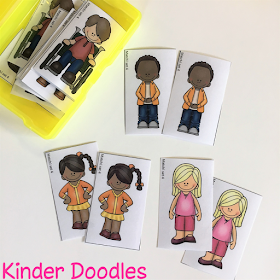 |
| My small group table ~ it's not always this tidy looking! |
I like to introduce working in station the first week of school (NOT the first day ~ geez, I'm just trying to survive & get them on the correct bus home.) Depending upon my group, we start building stamina on the second or third day. That first week of school isn't really academically rich; your time is spent mostly practicing procedures over and over. (...and over and over...) I've found that my students LOVE to work on building independent station stamina.
In order to get them to the place where I can meet with my small groups, I need to get everyone working at their stations. This is a daunting task! There is no way to get around the fact that you need to practice, practice, practice.
First, we cruise around the room and look at the different work stations so they know where they are located. Some stations are at tables, some on a shelf, some are in bins that can be taken to various spots around the room. The following photos are from past years ~ once the kids knew how to work independently.
Once we've taken a quick tour of our room, I ask the kids if they would like to try out the stations. Of course, this question is met with an enthusiastic yes! Before releasing them to stations, we discuss our classroom rules (I use the rules from Whole Brain Teaching.) We talk about how we also have rules for working in our stations: 1. Walk to your station. 2. Get started working right away. 3. Work quietly for the entire time. (We talk about how they are allowed to talk with their partner, but need to use quiet voices.) 4. Stay at your station. (If it is something in a bin, they can put it back to get another one when they are finished, but they can't roam around the room.) 5. When the timer goes off, quickly & carefully clean up your materials, and meet on the carpet. (I use a chime ringtone on my phone's timer.)
I assign my students the stations they go to each day. The stations have lots of choices within them. (When we are working on stamina, there are far fewer choices.) Typically, two students work at a station at a time. I've tried different numbers at a station, and have found that the kids are more likely to actually work when they have a partner rather than a group. Get my Literacy Station Rotation Cards Freebie HERE.
Ok, so by now we have had a quick tour of the work spaces, and gone over the rules. Yay! We are ready to go. The kids go to their assigned stations & start to work on building stamina. Because the work of building stamina is pretty hard, the tasks need to be pretty easy. Your little beginners need activities that require little to no instruction, don't take a long time to set up, do, and clean up. It's important to remember that at this point, the task isn't as important as the practice working independently is.
A few cans of playdough, puzzles, picture books, coloring books, and small building blocks are good choices for your practice sessions. Simple to use card activities also work well for your little learners. I have a set that contains four sets of five different activities that are perfect for early learning stations. Check them out HERE. The cards can also be used in morning tubs or for early finishers.
Your first "rounds" of station work will probably only last a few minutes. If you have a lot of off task behavior, gather the kiddos together and discuss the rules again. You may want to make an anchor chart to serve as a visual reminder of your expectations. Set your timer again & let them try it again.
As the kids get adept at staying at their stations, working the entire time, and staying on task, you will want to replace the more "toy-like" materials with things that are a little more academic. (You will still want to keep it simple, though.)
After the first week of practice, if the kids are able to stay on task for five or more minutes, I like to pull individual kids to my table to do some quick checks to see what they know so I can eventually form my small groups.
It takes lots of diligent practice, modelling, and reminders to get your kids ready for independent work. But, it pays off big time! Every class is different, so don't try to set a specific time frame for when you begin your guided reading groups. I've had groups ready to work independently while I pull small groups after about three weeks of practice, some take more time. Don't rush it! Taking time to practice, practice, practice will create a class that knows how to work independently. Good luck & have fun!
PS: If you want to quickly gather info on what your newbies know, you may be interested in my "What Do You Know Quick Check Bundle." Check it out HERE












No comments:
Post a Comment